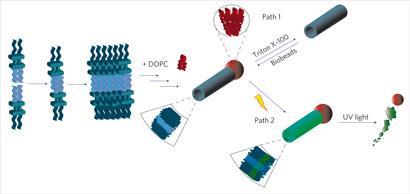Researchers have designed self-assembling nanotubes can be taken apart using just light
Dutch scientists have made self assembling nanotubes that are capped at the ends. Depending on the stimulus used, the tubes can be uncapped or disassemble in a controlled fashion, which could lead to applications in nanoengineering.
The group at the University of Groningen, led by Ben Feringa, made self assembling nanotubes from light sensitive amphiphiles. Like natural lipid molecules the new amphiphile has a polar ’head’ and hydrophobic ’tails’, so they arrange into bilayers. But the polar head molecule is special. When it is irradiated by light the molecule performs a cyclisation which changes its conformation. This means the amphiphiles can no longer fit together neatly and the tubes fall apart.

So far so good, but the nanotubes weren’t very long. To try and extend their length the team added an everyday phospholipid (DOPC) found in cell membranes. This resulted in longer tubes but the tubes now had an extra feature. At either end of the nanotubes were spherical vesicles of DOPC, a bit like bubbles at the end of a straw.
The nanotubes are up to 28nm wide and more than 10um long, yet can still be dismantled using light. The end caps can also be removed and then remade while the nanotube is still intact - popping the DOPC bubbles doesn’t break up the straw.
The work ’is evidence of the incredible ability materials scientists have to manipulate and engineer materials on the nanoscale,’ says Brent Sumerlin, who works on smart polymers that assemble and disassemble at the Southern Methodist University, Texas, US.
That was the aim of the work, Feringa says, to demonstrate how a complex nano-object can be controlled and made to change so significantly. But Sumerlin also suggests another use because of the adaptability of the system. ’The adaptability, which makes the materials so responsive,’ concludes Sumerlin, ’indicates applications in controlled drug delivery and nanoengineering.’
Laura Howes






No comments yet